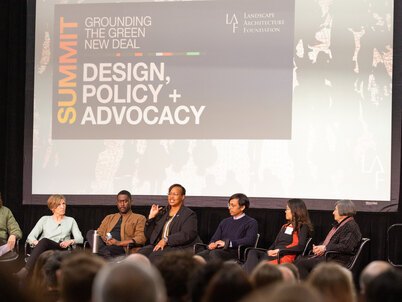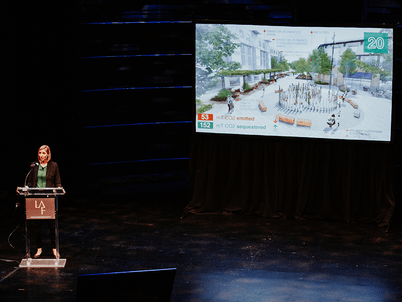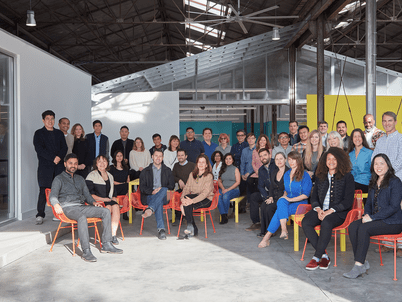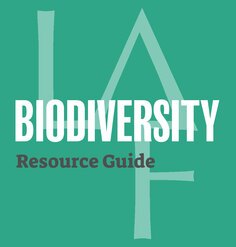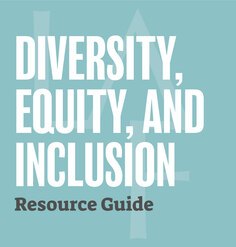Climate Change Resources
Understanding the urgency of the climate crisis and the role landscape architects can play in developing and implementing solutions, LAF has compiled resources to help you inform, design, and advocate.
Climate change is the defining issue of our time. Increases in temperature, more severe natural disasters, and more frequent droughts have all been scientifically linked to this manmade phenomenon. We are already feeling the effects of climate change and things will only get worse if we continue on with business as usual.
Landscape architects, with training in systems thinking, ecological planning, and cultural literacy, have a special role to play in mitigation and adaptation efforts. Further, landscape architects have a responsibility to advocate for those communities and natural systems made vulnerable by climate change but so often overlooked. Landscape architects' ability to understand and reach out to all stakeholders positions the profession well to advocate for climate and environmental justice.
Updated December 2023
Explore ideas to radically reimagine the future
From 2020 to 2022, LAF and partners undertook the Grounding the Green New Deal initiative to explore the intersection of design, policy, and advocacy and give form to the scale, scope, and pace of transformation needed to address the climate crisis.
The Green New Deal Superstudio was an open call to translate the goals of decarbonization, jobs, and justice into on-the-ground practices and built works. A curated set was selected from the 670 submissions to catalyze conversations and advocacy. The capstone summit featured panel discussions with leading changemakers to identify ways to accelerate individual and collective actions to effect change.
Check out the thought-provoking Superstudio projects and highlights from the summit conversations.
Inform: Understand the Problem
Learn the science behind climate change. Designing and advocating for climate change means first understanding the facts. It is a large and complicated issue but there are many resources available to explain the facts.
The Intergovernmental Panel on Climate Change (IPCC)
The IPCC is the most authoritative voice on climate change. The multinational body of researchers regularly publishes the Assessment Report on climate change which evaluates changes already being seen in the climate and offers models for what the future may look like. In 2018, the IPCC released a special report on 1.5 degrees (Celsius) of warming. The report and subsequent panels outline the bold action that must be taken to limit warming and protect millions of additional people from the dangerous effects of climate change.
Climate Nexus
Climate Nexus tells the stories of people and communities impacted by climate change. While the IPCC offers big-picture effects and scientific models, Climate Nexus backs up numbers with narrative and maps out impacts. From current events to issue areas including energy, health, and food, Climate Nexus shows how the impacts of climate expand far beyond the weather outside.
ACS Climate Science Toolkit
The American Chemical Society (ACS) has developed a Climate Science Toolkit to help everyone understand and communicate climate science. The ACS lays out how greenhouse gases, energy balance, and atmospheric warming function in a way that helps audiences follow along with the more technical reports such as those put out by the IPCC. The ACS also offers ideas for how to speak about climate change with others, even those who may be skeptical that humans can change such a large system.
AILA Climate Positive Design Guides
The Australian Institute of Landscape Architects (AILA) offers three downloadable volumes with detailed Climate Positive Design guidelines. These guides help landscape architects be part of climate solutions by understanding how to reach beyond carbon neutral and into climate positive for their projects and business operations and as individuals. The first volume offers advice for landscape architects, the second outlines the steps that a practice or business can take to be climate positive, and the third offers a roadmap for the AILA as an organization.
CSLA Adaptation Primers
The Canadian Society of Landscape Architects (CSLA) Adaptation Primers offer a deep dive into what climate change is and what it means for designers, policy-makers, and the public at large. With a specific eye toward the role landscape architects can play in addressing climate change and its effects, the four CSLA Primers lay a comprehensive foundation upon which to build climate knowledge.
The Water Will Come: Rising Seas, Sinking Cities, and the Remaking of the Civilized World
Humans have evolved to remember stories, not statistics, and this book from Jeff Goodell lays out a striking story of an Earth that has changed and is changing. Pairing a grim vision of the future with the facts faced by neighborhoods on the front lines of the changing climate, Goodell paints a picture that is hard to forget. For those who prefer a narrative to reports and statistics, start with The Water Will Come.
Seek out precedents for resilience and mitigation
LAF's Landscape Performance Series offers a searchable database of over 200 exemplary built projects with quantified environmental, economic, and social benefits.
A number of these projects were built to withstand the impacts of climate change and have had their landscape systems tested during extreme weather events. They can serve as models for resilient infrastructure that is built to "bend not break" with features like augmented shorelines, multi-purpose flood storage, and areas designed to experience partial submersion.
Check out the featured projects below or explore the entire case study library on LandscapePerformance.org.
Design: Set Bold Performance Goals
Landscape solutions can provide a range of benefits from flood protection to habitat creation to recreational value. But it is time to move beyond generalizations like green roofs reduce heat and trees sequester carbon. Landscape architects should work with clients to set specific performance objectives to design to. Taking that further, we need to measure how projects are actually performing once they are built and operating. Understanding performance is essential for ongoing management and future design innovation. Decision-makers will better recognize the value of landscape architecture and exemplary design if they can see quantifiable benefits.
Landscape Performance Series
The Landscape Architecture Foundation's (LAF) Landscape Performance Series is a set of resources to help designers, agencies, and advocates evaluate performance, show value, and make the case for sustainable landscape solutions. The library of Case Study Briefs offers quantified environmental, social, and economic benefits for built projects representing a variety of locations and project types. LAF works with teams of researchers and designers to produce new Case Study Briefs every year so the database of projects is always growing.
ASLA Climate Action
This suite of resources from the American Society of Landscape Architects (ASLA) offers many helpful links to learn about climate change and connect with national and international organizations working to address the issue. The Climate Action Plan puts forth a vision for the discipline to achieve by 2040, including achieving zero embodied and operational emissions and increasing carbon sequestration for all landscape architecture projects. ASLA’s Field Guide for Members offers guidance, toolkits, and resources to achieve the 2040 vision. Case Studies of built projects showcase how the work of landscape architects can reduce greenhouse gas emissions and increase communities’ resilience to climate impacts.
Climate Positive Design's Pathfinder Tool
This app-based calculator helps landscape architects to understand the climate impacts of their designs and the ways that they can design their projects to become climate positive, sequestering more carbon than they emit through construction and maintenance over the project's lifespan.
Sustainable SITES Initiative (SITES)
The Sustainable SITES Initiative (SITES) is a voluntary rating system that defines the criteria for sustainable land development, measures site performance, and ultimately elevates the value of landscapes. It can be applied to many project types including open spaces and streetscapes and plazas, as well as commercial, residential, educational, and institutional projects. SITES can be an essential guide in setting climate-related goals for a project and measuring progress toward those goals.
One Planet Living
Bioregional's One Planet Principles envision a socially and environmentally sustainable world. To meet current demand, the Earth's population consumes more resources than the planet can replenish each year, 1.7 Earths per year, to be exact. The One Planet Principles encourage equity, efficiency, and zero waste and carbon planning to bring that number down to 1.
Landscape Change: Climate Change Information for Landscape Architects
This website from the University of Florida's Departments of Landscape Architecture and Environmental Horticulture compiles relevant resources from public agencies, nonprofits, and leading practitioners that are specific to the needs and interests of landscape architects. In addition to providing foundational information to better understand climate change, its causes, and effects, the site also offers actionable design strategies.
Regeneration
Regeneration is a book and associated website by Paul Hawken that builds on his 2017 book Drawdown by offering actionable steps for individuals, organizations, and governments to reduce reliance on fossil fuels and “end the climate crisis in one generation.” Regenerative climate solutions are outlined in list form with topics ranging from afforestation to biochar to electric vehicles and fire ecology. The website invites users to create a “punch list” of personal, professional, and/or institutional actions and offers a carbon calculator to measure current carbon impact.
The Age of Sustainable Development
Setting sustainable development goals is the first step toward creating a sustainable future. However, even when goals are set it can be difficult to take action when they're so large and important. This book from Jeffrey Sachs turns those goals into measurable benchmarks. He offers tools and metrics to measure performance and progress toward global justice.
Handbook of Biophilic City Planning and Design
Timothy Beatley's book presses the importance of meaningful interactions with nature even in the densest urban centers. Green infrastructure offers many benefits from stormwater management to mental health. Further, without contact with nature, kids are less likely to take up the fight to protect the natural environment. The Handbook offers design ideas and inspiration to make sure urban residents benefit from nature and thoughts on how to advocate for biophilic design when it is not being valued.
Take inspiration from other landscape architects
Landscape architects are using their leadership and expertise to reshape the climate conversation and advocate for a range of design, policy, and funding solutions.
From municipal shoreline resilience specifications to carbon impact calculators, landscape architects have used the LAF Fellowship for Innovation and Leadership to advance big ideas and amplify their impact:
- Christopher Roth Hardy: Carbon Conscience Tool
- Erin Kelly: Climate Adaptation Finance
- Liz Camuti: Climate Resilience RFPs
- Pamela Conrad: Climate Positive Design
Learn about their work or get inspired to pursue your own big idea.
Advocate: Get Involved
Landscape architects need to use their individual and collective voices! They can act as leaders by making personal commitments to action and pushing others to do the same. Design firms can commit to making a positive impact on the climate and expect the same from their vendors and contractors. Designers can their values with the elected officials who represent them.
ASLA Climate Advocacy Resources
These climate change and resilience resources provide helpful language and knowledge for speaking with elected officials. Whether following a specific piece of legislation or looking for an opportunity to advocate for ASLA's Smart Policies for a Changing Climate, working with elected representatives and public agencies is an important avenue for addressing climate change.
Climate & Development Knowledge Network (CDKN)
CDKN recognizes the unique challenges developing nations face as they develop in the midst of a changing climate. Landscape architects can provide climate compatible development solutions to these policy-makers, solutions that not only promote equitable development but also bring awareness about the discipline and its multiple impacts to new audiences.
Climate Adaptation Knowledge Exchange (CAKE)
CAKE offers an opportunity to share knowledge about a variety of adaptation topics from planning to evaluation and is broken up into US regions to help better address the needs of different locales without painting the crisis with a broad brush. Climate change will not affect each region in the same way and this resource offers the specificity needed to promote awareness and advocacy at more local levels.
We Are Still In
We Are Still In is a coalition of local and state governments, tribal leaders, businesses, faith groups, and cultural institutions who remain committed to the goals set by the Paris Agreement. Signatories commit to taking action to meet the Paris Agreement's goals and limit the effects that climate change will have.
Peoples Climate Movement
The Peoples Climate Movement is a grassroots movement for climate, jobs, and justice. What began in 2014 with the Peoples Climate March continues to demand bold action on climate change through the twin strategies of mass mobilization and movement alignment. Core to their work is the rallying cry: "to change everything, we need everyone." A number of notable organizations, including 350.org, the Center for Popular Democracy, the Sierra Club, and the Sunrise Movement, take part in the Peoples Climate Movement. The organization's website offers resources for advocacy and opportunities to take action.
Make space for advocacy and activism
It is no longer enough to be a good designer; landscape architects need to be active designers, engaging in policy, politics, finance, community building, and more.
These articles, essays, and interviews showcase landscape architects and organizations that are using their unique perspective and talents to effect change.
- Advocacy at the Heart of Practice: Studio-MLA
- Urban Ecology as Activism by Kate Orff
- Landscape Architects as Advocates for Culture-Based Sustainable Development by Patricia M. O'Donnell
- Landscape Architects in Public Life interview with Billy Fleming
